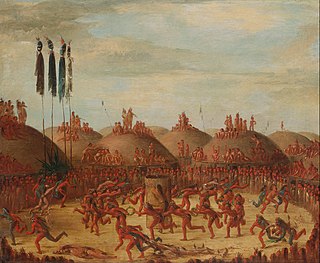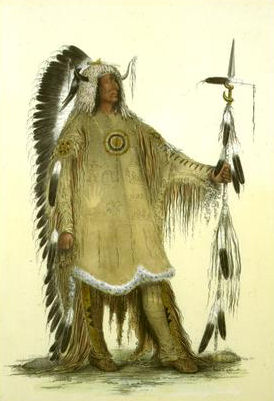The Mandan, Hidatsa, and Arikara Nation, also known as the Three Affiliated Tribes, is a Native American Nation resulting from the alliance of the Mandan, Hidatsa, and Arikara peoples, whose native lands ranged across the Missouri River basin extending from present day North Dakota through western Montana and Wyoming.

The Hidatsa are a Siouan people. They are enrolled in the federally recognized Three Affiliated Tribes of the Fort Berthold Reservation in North Dakota. Their language is related to that of the Crow, and they are sometimes considered a parent tribe to the modern Crow in Montana.

Arikara, also known as Sahnish, Arikaree, Ree, or Hundi, are a tribe of Native Americans in North Dakota. Today, they are enrolled with the Mandan and the Hidatsa as the federally recognized tribe known as the Mandan, Hidatsa, and Arikara Nation.

Henry Atkinson was a United States army officer serving on the western frontier during the War of 1812 and the Yellowstone expedition. With Benjamin O'Fallon, he negotiated treaties with Indigenous nations of the upper Missouri River in 1825. Over his career in the army, he served in the West, the Gulf Coast, and in New York at the border with The Canadas.

The Mandan are a Native American tribe of the Great Plains who have lived for centuries primarily in what is now North Dakota. They are enrolled in the Three Affiliated Tribes of the Fort Berthold Reservation. About half of the Mandan still reside in the area of the reservation; the rest reside around the United States and in Canada.

Fort Abraham Lincoln State Park is a North Dakota state park located 7 miles (11 km) south of Mandan, North Dakota, United States. The park is home to the replica Mandan On-A-Slant Indian Village and reconstructed military buildings including the Custer House.

The Fort Laramie Treaty of 1851 was signed on September 17, 1851 between United States treaty commissioners and representatives of the Cheyenne, Sioux, Arapaho, Crow, Assiniboine, Mandan, Hidatsa, and Arikara Nations. Also known as Horse Creek Treaty, the treaty set forth traditional territorial claims of the tribes.

Fort Atkinson was the first United States Army post to be established west of the Missouri River in the unorganized region of the Louisiana Purchase of the United States. Located just east of present-day Fort Calhoun, Nebraska, the fort was erected in 1819 and abandoned in 1827. The site is now known as Fort Atkinson State Historical Park and is a National Historic Landmark. A replica fort was constructed by the state at the site during the 1980s–1990s.

The Hunkpapa are a Native American group, one of the seven council fires of the Lakota tribe. The name Húŋkpapȟa is a Lakota word, meaning "Head of the Circle". By tradition, the Húŋkpapȟa set up their lodges at the entryway to the circle of the Great Council when the Sioux met in convocation. They speak Lakȟóta, one of the three dialects of the Sioux language.

Like-a-Fishhook Village was a Native American settlement next to Fort Berthold in North Dakota, United States, established by dissident bands of the Three Affiliated Tribes, the Mandan, Arikara and Hidatsa. Formed in 1845, it was also eventually inhabited by non-Indian traders, and became important in the trade between Natives and non-Natives in the region.

Mato-tope was the second chief of the Mandan tribe to be known as "Four Bears," a name he earned after charging the Assiniboine tribe during battle with the strength of four bears. Four Bears lived in the first half of the 19th century on the upper Missouri River in what is now North Dakota. Four Bears was a favorite subject of artists, painted by George Catlin and Karl Bodmer.

Thomas Fitzpatrick was an American-American fur trader, Indian agent, and mountain man. He trapped for the Rocky Mountain Fur Company and the American Fur Company. He was among the first white men to discover South Pass, Wyoming. In 1831, he found and took in a lost Arapaho boy, Friday, who he had schooled in St. Louis, Missouri; Friday became a noted interpreter and peacemaker and leader of a band of Northern Arapaho.

The history of South Dakota describes the history of the U.S. state of South Dakota over the course of several millennia, from its first inhabitants to the recent issues facing the state.
Fort Berthold was the name of two successive forts on the upper Missouri River in present-day central-northwest North Dakota. Both were initially established as fur trading posts. The second was adapted as a post for the U.S. Army. After the Army left the area, having subdued Native Americans, the fort was used by the US as the Indian Agency for the regional Arikara, Hidatsa, and Mandan Affiliated Tribes and their reservation.
This timeline of South Dakota is a list of events in the history of South Dakota by year.

Native Americans from various tribes lived in North Dakota before the arrival of settlers. With time, a number of treaties and agreements were signed between the Indians and the newcomers. Many of the treaties defined the domain of a specific group of Indians. The three maps below show the treaty territories of different Indians living in North Dakota and how the territories changed and diminished over time in the 19th century.

Arikara scouts were enlisted men from the Arikara Nation serving in the U.S. Army at different frontier posts in present-day North Dakota from 1868 to 1881. The enlistment period was six months with re-enlistment possible. Each scout received a uniform, firearm and drew rations. Scout duties ranged from carrying mail between commands to tracking down traditional enemies perceived as hostile by the Army in far ranging military campaigns. Detailed to secure the horses in located enemy camps, the scouts were often the first to engage in battle. The Arikara took part when the Army protected survey crews in the Yellowstone area in the early 1870s. They participated in the Great Sioux War of 1876 and developed into Colonel George Armstrong Custer's "… most loyal and permanent scouts …".
The Great Plains Indian trading networks encountered by the first Europeans on the Great Plains were built on a number of trading centers acting as hubs in an advanced system of exchange over great distances. The primary centers were found at the villages of the Mandan, Hidatsa, and Arikara, with a surplus of agricultural produce that could be exchanged. Secondary centers were found at the villages of the Pawnee, Kansa, and Osage on the central great plains, and at the Caddo villages on the southern plains. The Dakota rendezvous was an important annual trading fair among the Sioux. European demand for fur changed the relations of the plains, increased the occurrence of war, and displaced several Indian nations that were forced away by the Sioux coming from the east. On the northern plains, European trade lay in the hands of the Hudson's Bay Company, although most of the territory belonged to France, and later Spain. European trade on the central plains was controlled by French merchants, first from New Orleans, later from St. Louis. From the mid-1700s', the Comanche became an increasingly important military and commercial factor on the southern plains, forcing the Apaches into the mountains, and exchanging goods and spoils with the Southwestern trading networks hubs in New Mexico.
Edward Rose was an early American explorer, trapper, guide and interpreter. During his life, Rose alternated between residing with Native American tribes and working on behalf of commercial fur trapping expeditions funded by Eastern companies. His position at the intersection of these cultures made him a sought-after facilitator of communication and exchange of goods.

Benjamin O'Fallon (1793–1842) was an Indian agent along the upper areas of the Mississippi and Missouri Rivers. He interacted with Native Americans as a trader and Indian agent. He was against British trappers and traders operating in the United States and territories. He believed that the military should have taken a strong stance against the British and firm in negotiations with Native Americans. Despite his brash manner and contention with the military, he was able to negotiate treaties between native and white Americans. In his early and later careers, he built gristmills, was a retailer, and a planter. He collected Native American artifacts and paintings of tribe members by George Catlin. His uncle William Clark was his guardian and financial backer.



![Cloud-Shield's winter count (Lakota). 1823-24. "They joined the whites in an expedition up the Missouri River against the Rees [Arikaras]". Hundreds of Sioux Indians were the first to side with the U.S. army in an Indian war west of the Missouri. The event is recorded in some of the winter counts of the Lakotas. Cloud-Shield's winter count (Lakota). 1823-24. The Arikara War.png](http://upload.wikimedia.org/wikipedia/commons/thumb/9/97/Cloud-Shield%27s_winter_count_%28Lakota%29._1823-24._The_Arikara_War.png/220px-Cloud-Shield%27s_winter_count_%28Lakota%29._1823-24._The_Arikara_War.png)














